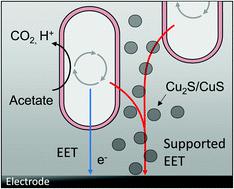当前位置:
X-MOL 学术
›
Energy Environ. Sci.
›
论文详情
Our official English website, www.x-mol.net, welcomes your
feedback! (Note: you will need to create a separate account there.)
Copper-bottomed: electrochemically active bacteria exploit conductive sulphide networks for enhanced electrogeneity
Energy & Environmental Science ( IF 32.4 ) Pub Date : 2020-08-13 , DOI: 10.1039/d0ee01281e Laura Beuth 1, 2, 3 , Catharina Philine Pfeiffer 1, 2, 3 , Uwe Schröder 1, 2, 3
Energy & Environmental Science ( IF 32.4 ) Pub Date : 2020-08-13 , DOI: 10.1039/d0ee01281e Laura Beuth 1, 2, 3 , Catharina Philine Pfeiffer 1, 2, 3 , Uwe Schröder 1, 2, 3
Affiliation

|
In this study, we demonstrate that anodic electroactive bacteria like Geobacter sulfurreducens generate copper(I) and copper(II) sulphides when grown on copper electrodes. The insoluble copper sulphides form a conductive network within the biofilms, strongly enhancing the biofilm electrogeneity – i.e., the ability of the biofilm to produce electric currents. Compared to biofilms grown on graphite, the average relative current density of copper-based biofilms was 237%, with a maximum geometric current density of 1.59 ± 0.23 mA cm−2. An additional electrochemical CuS deposition prior to biofilm cultivation further increased the bioelectrocatalytic current generation to 2 mA cm−2. The chemical deposition of CuS onto graphite allowed cultivating biofilms with current densities 134% higher than at unmodified graphite. This approach – the chemical CuS deposition onto inexpensive electrode materials – thus represents a promising pathway for the development of scalable, high-performance electrode materials for microbial electrochemical technologies.
中文翻译:

铜底:电化学活性细菌利用导电硫化物网络增强了电性
在这项研究中,我们证明,在铜电极上生长时,诸如减少细菌的地球细菌之类的阳极电活性细菌会生成铜(I)和铜(II)硫化物。不溶性硫化铜在生物膜内形成导电网络,从而大大增强了生物膜的电性,即生物膜产生电流的能力。与在石墨上生长的生物膜相比,铜基生物膜的平均相对电流密度为237%,最大几何电流密度为1.59±0.23 mA cm -2。在生物膜培养之前的额外电化学CuS沉积进一步将生物电催化电流的产生增加到2 mA cm -2。CuS的化学沉积在石墨上可以培养生物膜,其电流密度比未改性的石墨高134%。这种方法-将化学CuS沉积到廉价的电极材料上-代表了开发可扩展的,高性能的微生物电化学技术电极材料的有前途的途径。
更新日期:2020-09-16
中文翻译:

铜底:电化学活性细菌利用导电硫化物网络增强了电性
在这项研究中,我们证明,在铜电极上生长时,诸如减少细菌的地球细菌之类的阳极电活性细菌会生成铜(I)和铜(II)硫化物。不溶性硫化铜在生物膜内形成导电网络,从而大大增强了生物膜的电性,即生物膜产生电流的能力。与在石墨上生长的生物膜相比,铜基生物膜的平均相对电流密度为237%,最大几何电流密度为1.59±0.23 mA cm -2。在生物膜培养之前的额外电化学CuS沉积进一步将生物电催化电流的产生增加到2 mA cm -2。CuS的化学沉积在石墨上可以培养生物膜,其电流密度比未改性的石墨高134%。这种方法-将化学CuS沉积到廉价的电极材料上-代表了开发可扩展的,高性能的微生物电化学技术电极材料的有前途的途径。











































 京公网安备 11010802027423号
京公网安备 11010802027423号